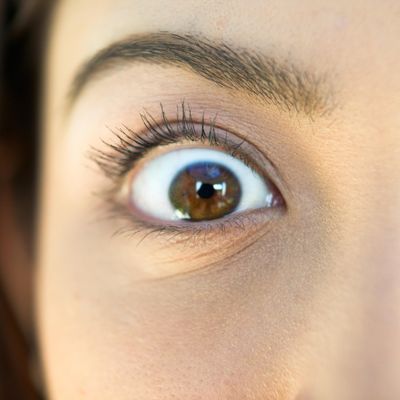
Many of us have been here: You’re talking to a co-worker and all of a sudden your lower eyelid starts to spasm. It feels as though your dark circles are tap-dancing, so you start planning your exit strategy: “Need more coffee, talk later!” You scurry to your desk and press your fingers against your eyelid as if that will halt the movement, or at least reassure the poor thing. Then it stops.
While a twitching eyelid doesn’t hurt, it’s certainly annoying and can be scary if it’s never happened before. The good news is it’s usually harmless, says Philip Rizzuto, M.D., an associate professor of ophthalmology at Brown University’s Alpert Medical School and a spokesperson for the American Academy of Ophthalmology. Minor eyelid twitch (known by docs as myokymia) usually happens in just one eye and can be caused by stress, fatigue, irritation of the eyelid lining or cornea, and copious amounts of caffeine or alcohol.
While the A.A.O. suggests contacting an ophthalmologist if the spasms continue for longer than a week, Dr. Rizzuto says if a patient is concerned enough to call, he’ll have them come in no matter how long it’s been. He can check to see if they have any particles on the surface of their eye and will ask when the twitching happened and what was going on then. “If it happens all of a sudden and you were stressed and anxious at that time, then we try to address the behavioral factors,” he says. In other words, he’ll tell you to skip that third cup of the coffee, drink less, and get more sleep. You can also try eye drops to reduce irritation, but they’re more like a Band-Aid for the underlying cause. “I’m a big proponent of artificial tears and eye drops for comfort but not as a cure,” he says.
If this happens to you at work more than anywhere else, you might wonder if your computer is to blame. Dr. Rizzuto says devices aren’t recognized as a cause of twitching, though it does stand to reason that if your eyes are pried open, staring at the screen for hours on end, they would get irritated. “I tell people to take a break — close your eyes for a minute,” he says. “Maybe you don’t want people to see you doing that at your desk, but a lot of my patients say it helps.”
Now, if the twitching affects both eyes, or one or both lids completely shuts as a result, that’s something different called benign essential blepharospasm. It usually develops between the ages of 40 and 60 and can worsen over time. It’s not terribly common: Experts estimate that there are 2,000 new cases diagnosed annually. There’s currently no cure, but Botox injections in the eyelid muscles can reduce the twitching, though they’ll need to be repeated.
There is a third, unusual, somewhat terrifying option: a hemifacial spasm, which is when your eyelid and facial muscles on the same side freak out. It could be the result of damage or pressure on one of your facial nerves, Dr. Rizzuto says. Uncommonly, that pressure could be caused by a tumor, so you should get an appointment with an eye doctor pretty much immediately to figure out what’s causing the spasm. For all the hypochondriacs who just completely freaked out, a tumor is a very rare cause of a very rare kind of spasm, one that’s estimated to affect ten in 100,000 people.
The majority of people with excitable eyelids are just overly caffeinated or stressed or tired. So treat yourself to some TLC and that tap-dancing should subside on its own.

